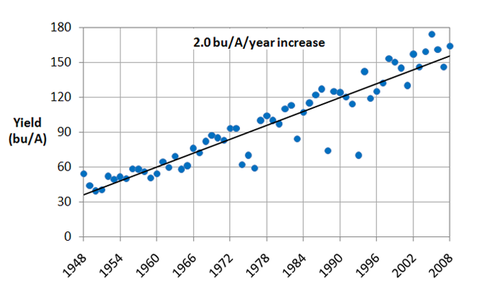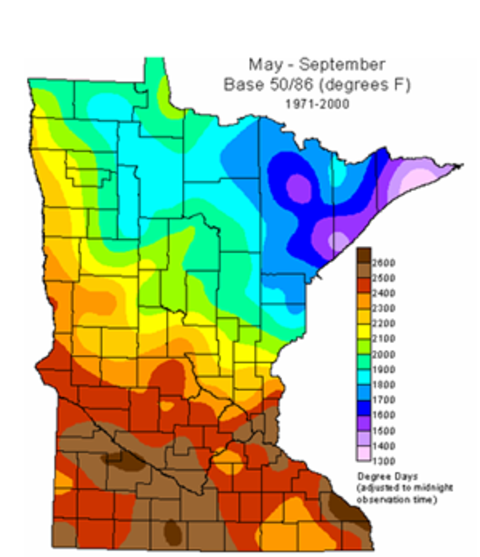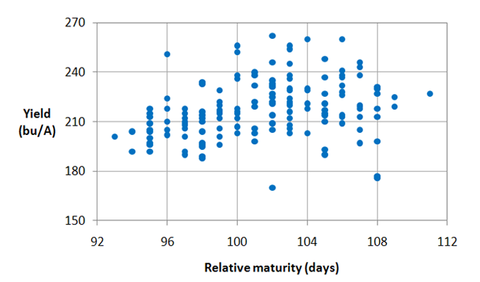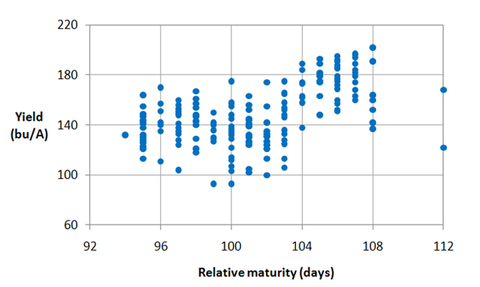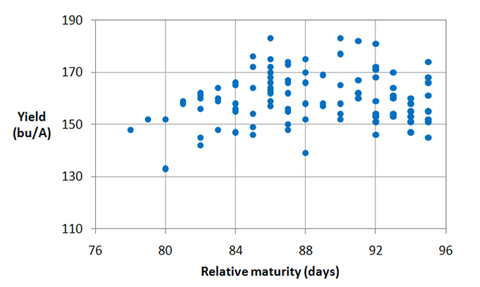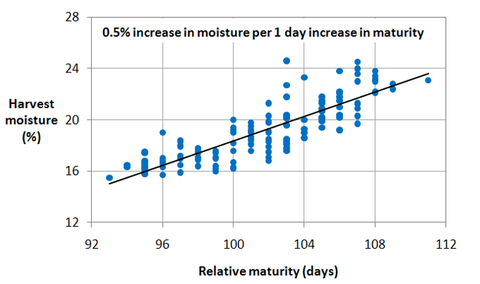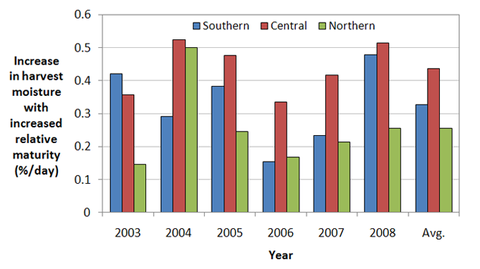Hybrid selection is one of the most important agronomic decisions for corn production.
Hybrids that consistently perform well over multiple locations or years in a region are desirable because next year’s growing conditions are uncertain.
Consider trial results from multiple sources, including universities, grower associations, seed companies and on-farm trials.
Results from University of Minnesota corn grain performance trials
View the results of other corn trials at:
Hybrids are turning over at a faster rate than ever before. Try new and unproven hybrids on limited acreage to see how they do in your fields. As more information becomes available, these hybrids can begin to play a larger role in your corn production system.
How to select corn hybrids for grain production
Identify an acceptable maturity range based on the growing degree days (GDDs) required for a hybrid to reach maturity. Selected hybrids should reach maturity at least 10 days before the first average freeze to allow time for grain dry-down and to provide a buffer in a cool year or if planting is delayed.
Plant multiple hybrids of varying maturity to widen the harvest time frame. Planting hybrids of ranging maturities also widens the timeframe for pollination, reducing the risk that an entire crop will experience hot and dry conditions during pollination.
Remember that full-season hybrids do not consistently out-yield mid-season hybrids in the Upper Midwest. There’s more variability in grain yield among hybrids within a given relative maturity group than there is between maturity groups.
Select hybrids according to agronomic traits, including suitability for a given crop rotation, emergence, root strength, standability and tolerance to diseases, drought, insect pests and herbicides.
Impact on yield
Since 1948, the average corn yield in Minnesota has increased steadily at a rate of two bushels per acre per year (Figure 1), due to improved hybrids and agronomic practices. This underscores the importance of hybrid selection.
Maturity and growing degree days
In the northern Corn Belt, maturity is one of the most important factors to consider when selecting hybrids. Hybrid maturity is rated using the relative maturity (RM) and/or GDD rating systems.
With the RM system, hybrid maturity is expressed in days. This does not represent the number of days required from emergence to physiological maturity. Rather, it’s a relative measure of maturity for a given hybrid compared to hybrids of known maturity.
Although there’s no industry standard for measuring RM, hybrid RM across companies closely relates to the number of GDDs required from planting to maturity. Generally, a 95-day RM hybrid needs between 2,350 and 2,400 GDDs from planting to maturity, with each one-day increase in RM increasing the GDD requirement for a hybrid by an average of 22 GDDs (Figure 2).
The GDD system for rating hybrid maturity allows one to compare a hybrid’s GDD requirements with the number of GDDs that typically occur during the growing season for a given location and planting date (Tables 1-7 and Figure 3). Daily GDDs are calculated based on daily high and low temperatures (measured in degrees Fahrenheit) according to the following equation:
GDD = [(High + Low)/2] - 50 degrees F
where “High” is the daily high (set at 86 degrees F if the daily high is above 86) and “Low” is the daily low (set at 50 degrees if the daily low is less than 50).
Selected hybrids should reach maturity at least ten days before the first average frost (32 degrees F) . This allows time for grain dry-down prior to harvest along with a buffer in case planting is delayed or GDD accumulation lags behind normal.
In addition, consider planting multiple hybrids of varying maturity, as this reduces the probability that an entire crop will experience hot and dry conditions during the critical pollination period.
Average GDD accumulation for various planting dates
Tables 1-7 show the average growing degree day (GDD) accumulation (1971-2000) until the first average frost for six planting dates in locations across Minnesota.
First fall frosts are shown as median dates of critical fall temperatures (1948-2005) across Minnesota. To adjust for 10 days before the average frost (to allow for drying), subtract those GDDs from the larger number at your planting date.
While the number of GDDs available to a crop reduces with delayed planting, a hybrid’s GDD requirement is also reduced as planting date is delayed. For example, research from Indiana shows a hybrid’s GDD requirement reduces by 6.8 GDDs for each one-day delay in planting beyond May 1.
By region: Growing degree days by planting date and first fall frost dates
Southwest Minnesota GDDs by planting date and median date of first fall frost
| Location | Planted April 20 | Planted April 30 | Planted May 10 | Planted May 20 | Planted May 30 | Planted June 9 | GDD adjustment (for drying)* | First fall frost (32 degrees F) | First fall frost (28 degrees F) |
|---|---|---|---|---|---|---|---|---|---|
| Lamberton | 2,596 | 2,540 | 2,458 | 2,348 | 2,210 | 2,046 | 109 | Sept. 28 | Oct. 7 |
| Marshall | 2,703 | 2,647 | 2,565 | 2,456 | 2,320 | 2,158 | 97 | Oct. 4 | Oct. 14 |
| Pipestone | 2,460 | 2,408 | 2,322 | 2,230 | 2,104 | 1,954 | 115 | Sept. 24 | Oct. 3 |
| Redwood Falls | 2,797 | 2,734 | 2,643 | 2,525 | 2,378 | 2,206 | 109 | Oct. 2 | Oct. 9 |
| Worthington | 2,440 | 2,394 | 2,322 | 2,224 | 2,100 | 1,951 | 96 | Sept. 30** | Oct. 7** |
*Adjusted GDD to allow for 10 days of drying before the first fall frost (32 degrees Fahrenheit).
**Worthington frost dates were unavailable, so Windom was used.
Sources: Minnesota Department of Natural Resources corn growing degree day normals and first fall freeze and frost date probabilities.
South Central Minnesota GDDs by planting date, and median date of first fall frost
| Location | Planted April 20 | Planted April 30 | Planted May 10 | Planted May 20 | Planted May 30 | Planted June 9 | GDD adjustment (for drying)* | First fall frost (32 degrees F) | First fall frost (28 degrees F) |
|---|---|---|---|---|---|---|---|---|---|
| Faribault | 2,484 | 2,434 | 2,361 | 2,263 | 2,138 | 1,987 | 103 | Sept. 29 | Oct. 12 |
| Mankato | 2,624 | 2,568 | 2,487 | 2,379 | 2,246 | 2,088 | 100 | Oct. 2** | Oct. 13** |
| Waseca | 2,547 | 2,494 | 2,415 | 2,308 | 2,175 | 2,018 | 105 | Sept. 30 | Oct. 6 |
| Winnebago | 2,695 | 2,637 | 2,554 | 2,444 | 2,308 | 2,146 | 95 | Oct. 6 | Oct. 17 |
*Adjusted GDD to allow for 10 days of drying before the first fall frost (32 degrees Fahrenheit).
**Mankato frost dates were unavailable, so St. Peter was used.
Sources: Minnesota Department of Natural Resources corn growing degree day normals and first fall freeze and frost date probabilities.
Southeast Minnesota GDDs by planting date, and median date of first fall frost
| Location | Planted April 20 | Planted April 30 | Planted May 10 | Planted May 20 | Planted May 30 | Planted June 9 | GDD adjustment (for drying)* | First fall frost (32 degrees F) | First fall frost (28 degrees F) |
|---|---|---|---|---|---|---|---|---|---|
| Preston | 2,342 | 2,294 | 2,225 | 2,133 | 2,016 | 1,873 | 119 | Sept. 23 | Oct. 3 |
| Red Wing | 2,560 | 2,503 | 2,423 | 2,318 | 2,188 | 2,034 | 118 | Sept. 26** | Oct. 4** |
| Rochester | 2,378 | 2,329 | 2,258 | 2,163 | 2,045 | 1,904 | 94 | Oct. 1 | Oct. 12 |
| Winona | 2,690 | 2,633 | 2,553 | 2,447 | 2,315 | 2,158 | 91 | Oct. 7 | Oct. 20 |
*Adjusted GDD to allow for 10 days of drying before the first fall frost (32 degrees Fahrenheit).
**Red Wing frost dates were unavailable, so Zumbrota was used.
Sources: Minnesota Department of Natural Resources corn growing degree day normals and first fall freeze and frost date probabilities.
West Central Minnesota GDDs by planting date and median date of first fall frost
| Location | Planted April 20 | Planted April 30 | Planted May 10 | Planted May 20 | Planted May 30 | Planted June 9 | GDD adjustment (for drying)* | First fall frost (32 degrees F) | First fall frost (28 degrees F) |
|---|---|---|---|---|---|---|---|---|---|
| Alexandria | 2,316 | 2,271 | 2,202 | 2,109 | 1,995 | 1,860 | 83 | Oct. 1 | Oct. 12 |
| Canby | 2,713 | 2,656 | 2,573 | 2,465 | 2,329 | 2,169 | 105 | Oct. 1 | Oct. 10 |
| Fergus Falls | 2,328 | 2,282 | 2,211 | 2,117 | 1,999 | 1,861 | 92 | Sept. 28 | Oct. 8 |
| Montevideo | 2,559 | 2,506 | 2,409 | 2,326 | 2,196 | 2,042 | 102 | Sept. 30 | Oct. 7 |
| Morris | 2,474 | 2,422 | 2,345 | 2,241 | 2,114 | 1,964 | 96 | Sept. 29 | Oct. 6 |
| Wheaton | 2,531 | 2,481 | 2,407 | 2,308 | 2,184 | 2,034 | 91 | Oct. 1 | Oct. 10 |
*Adjusted GDD to allow for 10 days of drying before the first fall frost (32 degrees Fahrenheit).
Sources: Minnesota Department of Natural Resources corn growing degree day normals and first fall freeze and frost date probabilities.
East Central Minnesota GDDs by planting date, and median date of first fall frost
| Location | Planted April 20 | Planted April 30 | Planted May 10 | Planted May 20 | Planted May 30 | Planted June 9 | GDD adjustment (for drying)* | First fall frost (32 degrees F) | First fall frost (28 degrees F) |
|---|---|---|---|---|---|---|---|---|---|
| Aitkin | 1,904 | 1,869 | 1,812 | 1,735 | 1,639 | 1,525 | 82 | Sept. 24 | Sept. 30 |
| Forest Lake | 2,491 | 2,439 | 2,363 | 2,260 | 2,135 | 1,987 | 86 | Oct. 5 | Oct. 17 |
| Hinckley | 1,980 | 1,944 | 1,886 | 1,807 | 1,708 | 1,591 | 90 | Sept. 22 | Sept. 28 |
| Rosemount | 2,505 | 2,452 | 2,377 | 2,279 | 2,156 | 2,007 | 92 | Oct. 4** | Oct. 14** |
*Adjusted GDD to allow for 10 days of drying before the first fall frost (32 degrees Fahrenheit).
**Rosemount frost dates were unavailable, so Farmington was used.
Sources: Minnesota Department of Natural Resources corn growing degree day normals and first fall freeze and frost date probabilities.
Northwest Minnesota GDDs by planting date, and median date of first fall frost
| Location | Planted April 20 | Planted April 30 | Planted May 10 | Planted May 20 | Planted May 30 | Planted June 9 | GDD adjustment (for drying)* | First fall frost (32 degrees F) | First fall frost (28 degrees F) |
|---|---|---|---|---|---|---|---|---|---|
| Crookston | 2,245 | 2,201 | 2,131 | 2,037 | 1,919 | 1,781 | 98 | Sept. 23 | Oct. 2 |
| Itasca | 1,805 | 1,777 | 1,728 | 1,657 | 1,566 | 1,456 | 81 | Sept. 20 | Sept. 26 |
| Moorhead | 2,365 | 2,316 | 2,242 | 2,142 | 2,020 | 1,876 | 103 | Sept. 24** | Oct. 3** |
| Warroad | 1,935 | 1,906 | 1,855 | 1,782 | 1,686 | 1,568 | 77 | Sept. 23 | Sept. 30 |
*Adjusted GDD to allow for 10 days of drying before the first fall frost (32 degrees Fahrenheit).
**Moorhead frost dates were unavailable, so Ada was used.
Sources: Minnesota Department of Natural Resources corn growing degree day normals and first fall freeze and frost date probabilities.
Yield and relative maturity
Within a given region, mid- to full-season hybrids generally have higher yield potential than early-maturing hybrids (Figures 4 through 9), as they utilize more of the GDDs available during the season.
However, in Minnesota it’s rare for very full-season hybrids to out-yield the mid-season hybrids. There’s also more variability in yield among hybrids within a given RM rating than between maturity groups, further underscoring the importance of hybrid selection.
Grain moisture and relative maturity
Another important consideration is that grain moisture at harvest increases steadily with increasing relative maturity (Figure 10). On average, grain moisture at harvest increases by 0.25-0.44 percent with each one-day increase in relative maturity (Figure 11). Selecting hybrids of appropriate maturity is important to balance between yield potential and grain moisture at harvest.
Agronomic traits
After you identify a set of consistently high-yielding hybrids within your maturity range, base further selection within this group on specific agronomic traits. Choosing a hybrid with a strong balance of agronomic traits is important for managing risk, but the relative importance of individual traits differs with production practices and growing conditions.
Important agronomic considerations include standability, tolerance to diseases and drought, transgenic resistance to insects and herbicides within a given production system and good emergence under cool conditions.
Standability
Standability is a common agronomic trait that’s critical for ensuring harvestable grain. Since corn has a narrow optimum plant population, unharvestable ears due to stalk and root lodging will greatly impact yield.
In a 2005 hybrid trial conducted in northwest Iowa where severe lodging was present, each 1 percent increase in lodging reduced yield by an average of 0.5 bushels per acre. Standability is particularly important for corn that will be planted at a higher population, or for corn likely to be under drought stress. This is because stalk diameter decreases with increasing plant population, and because drought stress favors stalk rot.
Growers can easily evaluate the standability of a hybrid in a given field using the late-season push test, where plants are pushed 45 degrees (about 10 inches) from vertical at ear level. Plants that break after the push test are at risk for stalk lodging.
Stalk strength can also be evaluated by pinching the lower stalk at the first internode above the brace roots, as hollow and deteriorated stalks will easily collapse when pinched.
With both the push and pinch tests, growers should test at least 20 plants in five representative locations within a field. Fields with 10 to 15 percent or more of the plants failing the push or pinch test are at risk for severe stalk lodging, and should be placed at the top of the harvest list to prevent harvesting downed corn later.
Insect resistance
Transgenic traits for insect resistance can be useful for protecting stalks and roots, but it’s important to note that these traits alone will only influence yield if there's pressure from the target pests.
Emergence
When selecting hybrids, growers should also consider emergence. Early planting is important for high corn yields, but the soil in late April is often cool and wet, causing many stresses on young seedlings. This makes strong emergence a key agronomic trait, particularly for fields with heavy soil and abundant surface residue that will be planted early.
Elmore, R., Abendroth, L. & Rouse, J. (2006). Choosing corn hybrids. Available at https://lib.dr.iastate.edu/cgi/viewcontent.cgi?article=2205&context=cropnews
Hall, R.G. & Reitsma, K.D. (2009). Corn hybrid selection. p. 9-12. In Clay, D.E., Reitsma, K.D. and Clay, S.A. (ed.) Best management practices for corn production in South Dakota.
National Corn Growers Association. (2021). NCYC guide archives.
Nielsen, R.L. & Thomison, P. (2003). Purdue. Delayed planting and hybrid maturity decisions.
Reviewed in 2021


